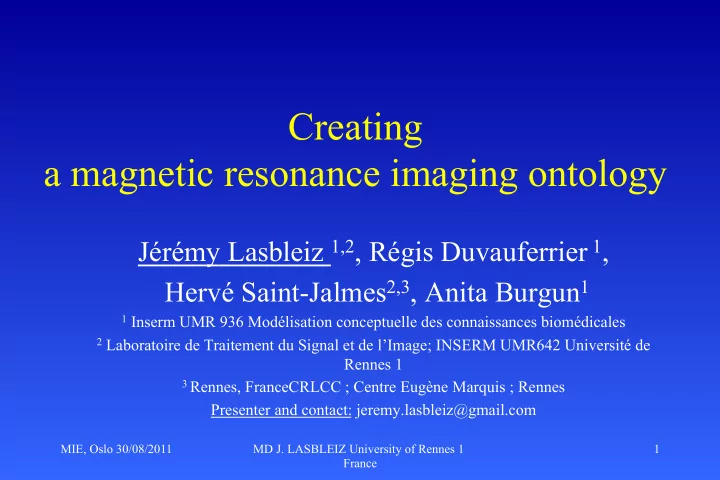

Creating a magnetic resonance imaging ontology Jérémy Lasbleiz 1,2 , Régis Duvauferrier 1 , Hervé Saint-Jalmes 2,3 , Anita Burgun 1 1 Inserm UMR 936 Modélisation conceptuelle des connaissances biomédicales 2 Laboratoire de Traitement du Signal et de l’Image; INSERM UMR642 Université de Rennes 1 3 Rennes, FranceCRLCC ; Centre Eugène Marquis ; Rennes Presenter and contact: jeremy.lasbleiz@gmail.com MIE, Oslo 30/08/2011 MD J. LASBLEIZ University of Rennes 1 1 France
Context Context • MRI: • MRI: – The – The most versatile diagnostic imaging technic – Wide range of vocabulary (semantic interoperability ) • Ontology – Web semantic : – allows Semantic interoperability – Already used in a radiological context but not for MRI – Will allow us to make • DICOM standard for communication MIE, Oslo 30/08/2011 MD J. LASBLEIZ University of Rennes 1 2 MD J. LASBLEIZ University of Rennes 1
study parameters => T1, T2, diffusion…) : sequence and • medical interpretation of MRI, technical data are Goal => Create an ontology which gives informations, help radiologists for MRI interpretations relevant from DICOM headers to relevant informations, extracted from DICOM headers to help radiologists for MRI interpretations MIE, Oslo 30/08/2011 MD J. LASBLEIZ University of Rennes 1 3 France
Example • What • What are those sequences MIE, Oslo 30/08/2011 MD J. LASBLEIZ University of Rennes 1 4 France
Material and Method • Domain analysis – Analyzing DICOM standard – Analyzing DICOM headers of MRI exams – Knowledge coming from JEMRIS (MRI simulator) High concepts needed to be relevant for radiologists • Sequence: set of preselected RF occuring in a magnetic field • Parameters: technical features that influence MRI results • Sequence results: Contrast imaging T1, T2… MIE, Oslo 30/08/2011 MD J. LASBLEIZ University of Rennes 1 5 France
Material and Method • Create the ontology using Protégé 4 owl2 – Taxonomy – Relations – Formal definitions with quantitative data (owl2) • Ontology had been Validated with DICOM headers analysis – extracted thanks to OSIRIX MIE, Oslo 30/08/2011 MD J. LASBLEIZ University of Rennes 1 6 France
Results Sequences The sequences taxonomy free ourselves from constructors terminology Coherent Gradient Echo Elscint F SHORT Fonar Field Echo GE GRASS, FGR, FMPGR Hitachi Rephased SARGE, GFEC Philips FFE Picker FAST Siemens FISP Toshiba Field Echo MIE, Oslo 30/08/2011 MD J. LASBLEIZ University of Rennes 1 7 France
Results Parameters and Sequence goals • Parameters – Contrast / Resolution/ are Specific of the sequence Goal • Sequence goal – Calibration Sequence – Localisation Sequence – ContrastSequence (T1, T2, Proton Density, T2 star) – Spectroscopy – Perfusion Imaging – MagneticResonanceAngiography – DiffusionImaging MIE, Oslo 30/08/2011 MD J. LASBLEIZ University of Rennes 1 8 France
Results Relations and Relations and Formal Results • Relations: are to • Relations: are to make the linkage between give a formal definition concepts and : – Sequence – Technical Parameters – Sequence • For example Spin Echo T2 weighted sequence (definition) some ((RT and (Has_Unit some milisecond (Has_Value some float [>=2000])) and (ET and (Has_Unit some milisecond ) and and ( ) MIE, Oslo 30/08/2011 MD J. LASBLEIZ University of Rennes 1 9 MD J. LASBLEIZ University of Rennes 1
Results Results validation had • DICOM tags had • DICOM tags been added been added as synonyms Spin Echo (0018,0020) RT (0018,0080)>2000ms Spin Echo T2 weighted sequence MIE, Oslo 30/08/2011 MD J. LASBLEIZ University of Rennes 1 10 France
Discussion • This applicative ontology is a good representation of MRI sequences • During the ontology validation we had to face to problems: – DICOM header filling defects • Body part examined is almost never mentioned – Pb for T1 and T2 calculation / security • Sequence names are located into different DICOM tags (0018,0020; 0018,0024 (Siemens); 0018,0023 (General Electric)….) MIE, Oslo 30/08/2011 MD J. LASBLEIZ University of Rennes 1 11 France
Conclusion • The need of semantic interoperability for MRI is obvious • Difficulties to make an automatic applicative ontology because of missing informations in DICOM headers (could be solved after obtaining DICOM tag locations from constructors) • Next step: to introduce an automatic tool for PACS MIE, Oslo 30/08/2011 MD J. LASBLEIZ University of Rennes 1 12 France
Recommend
More recommend